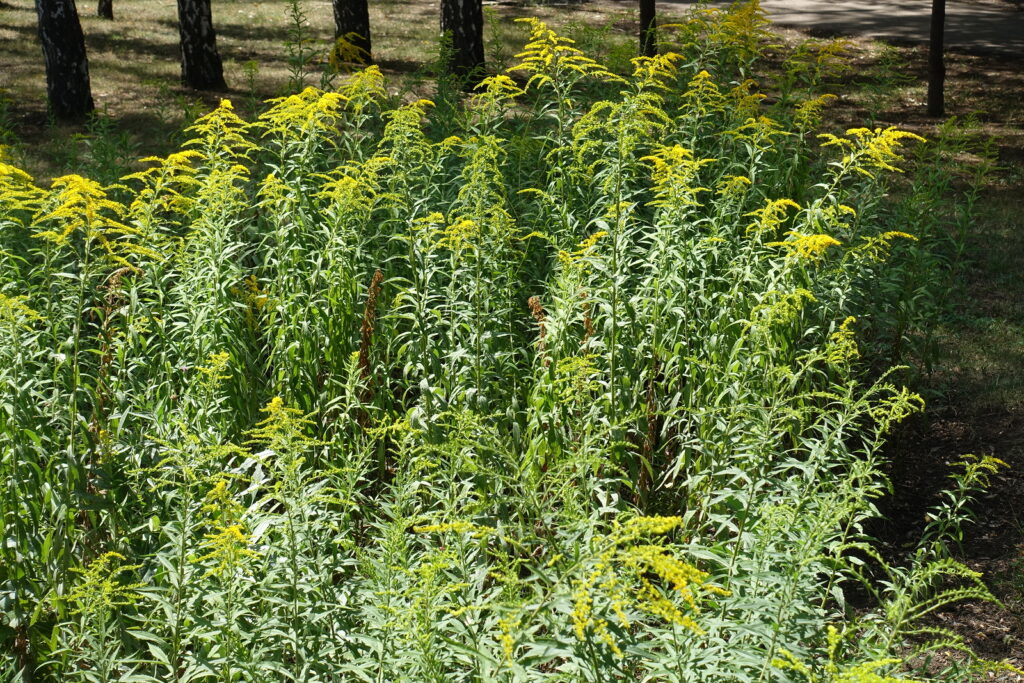Solidago, commonly called goldenrod, produces branching heads of golden yellow blooms from mid-to-late summer. Solidago is an upright, clump-forming perennial with slender, pointed green leaves. The plant may need staking.
Solidago is a good choice for color in the late summer border or wild garden. Solidago is a good cut flower. Plant Solidago where it will not overwhelm less vigorous plants.
Solidago is a genus of about 100 species of woody-based perennials. They have small, elongated flowerheads mostly borne in one-sided, upward-facing racemes or spike-like panicles.

Get to know Solidago
- Plant type: Perennial
- Growing Zones and range: Zones 4-8
- Hardiness: Hardy to -30°F (-18°C)
- Height and width: 12 to 36 inches (30-91cm) tall; 12 to 20 inches (30-50cm) wide, depending on the variety
- Foliage: Narrowly elliptic to lance-shaped entire or toothed mid green-leaves
- Flowers: Elongated sprays of flowers borne in one-sided, upward-facing racemes
- Flower color: Bright yellow flowers
- Bloom time: Late summer and fall
- Uses: Mixed borders, meadow and cottage gardens, cutting garden
- Common name: Goldenrod
- Botanical name: Solidago hybrids
- Family: Asteraceae
- Origin: North America
Where to plant Solidago
- Plant Solidago in full sun.
- Solidago grows in average to poor soil that is well-drained.
Solidago uses and companions
- Use Solidago in a late-summer border or wild garden.
- Solidago are good cut flowers.
- Good garden companions for Solidago include Aster, Boltonia asteroides, Chrysanthemum, Echinancea purperuea, Gaillardia grandiflora, Helenium, Helianthus, ornamental grasses.

When to plant Solidago
- Set Solidago in the garden in spring.
- Sow seed in spring in the garden.
- Divide Solidago in spring or autumn.
Planting and spacing Solidago
- Space Solidago 12 to 20 inches (30-50cm) apart.
How to water and feed Solidago
- Solidago needs moderate moisture; keep the soil evenly moist.
- Solidago does not need to be fertilizing. Fertilizing can result in plat growing leggy.
Solidago care
- Mulch around Solidago to conserve soil moisture.
- Trim off spent flowers to encourage new blooms.
- Solidago is usually pest and disease-free.
Solidago pests and diseases
- Solidago is susceptible to spot anthracnose, powdery mildew, rust, and fungal spots.

Solidago propagation
- Solidago seeds germinate in 14 to 21 days at 70°F (21°C) .
- Divide plant in mid-autumn or early spring.
Solidago varieties to grow
- Solidago rugosa: Grows to 5 feet (1.5m) tall with flowers on widely branching arching stems. Cultivars include ‘Fireworks’ has pure yellow flowers and red-tinged foliage; ‘Golden Baby’ is a compact and disease resistant cultivar that grows 18 to 24 inches (45-61cm) tall; ‘Peter Pan’ has bright yellow flowers and grows 2 to 3 feet (.6-1m) tall.
- S. sphacelata ‘Golden Fleece’: grows to 24 inches (61cm) tall; low foliage mound; good ground cover.
- S. virgaurea: Grows to 3 feet (1m) tall with flower clusters on a spike. Cultivars include ‘Cloth of Gold’, ‘Strahlenkrone’, and ‘Goldenmosa.’
- Solidaster luteus: Hybrid of goldenrod and a perennial aster; grows to 2 feet (.6m) tall; resembles goldenrod but has larger, softer yellow flowers like small asters.



